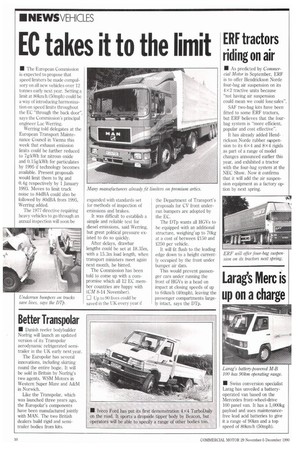EC takes it to the limit
Page 12

If you've noticed an error in this article please click here to report it so we can fix it.
• The European Commission is expected to propose that speed limiters be made compulsory on all new vehicles over 12 tonnes early next year. Setting a limit at 80km/h (50mph) could be a way of introducing harmonisation on speed limits throughout the EC "through the back door", says the Commission's principal engineer Luc Werring.
Werring told delegates at the European Transport Maintenance Council in Vienna this week that exhaust emission limits could be further reduced to 7g/kWh for nitrous oxide and 0.15g/kWh for particulates by 1995 if technology becomes available. Present proposals would limit them to 9g and 0.4g respectively by 1 January 1993. Moves to limit truck noise to 84dBA could also be followed by 80dBA from 1995, Werring added.
The 1977 directive requiring heavy vehicles to go through an annual inspection will soon be expanded with standards set for methods of inspection of emissions and brakes.
It was difficult to establish a simple and reliable test for diesel emissions, said Werring, but great political pressure existed to do so quickly.
After delays, drawbar lengths could be set at 18.35m, with a 15.3m load length, when transport ministers meet again next month, he hinted.
The Commission has been told to come up with a compromise which all 12 EC member countries are happy with (CM 8-14 November).
Up to 90 lives could be saved in the UK every year if the Department of Transport's proposals for CV front underrun bumpers are adopted by the EC.
The Dip wants all HGVs to he equipped with an additional structure, weighing-up to 70kg at a cost of between £150 and £250 per vehicle.
It will fit flush to the leading edge down to a height currently occupied by the front under bumper air dam.
This would prevent passenger cars under running the front of HGVs in a head on impact at closing speeds of up to 64km/h (40mph), leaving the passenger compartments largely intact, says the DTp.












































































